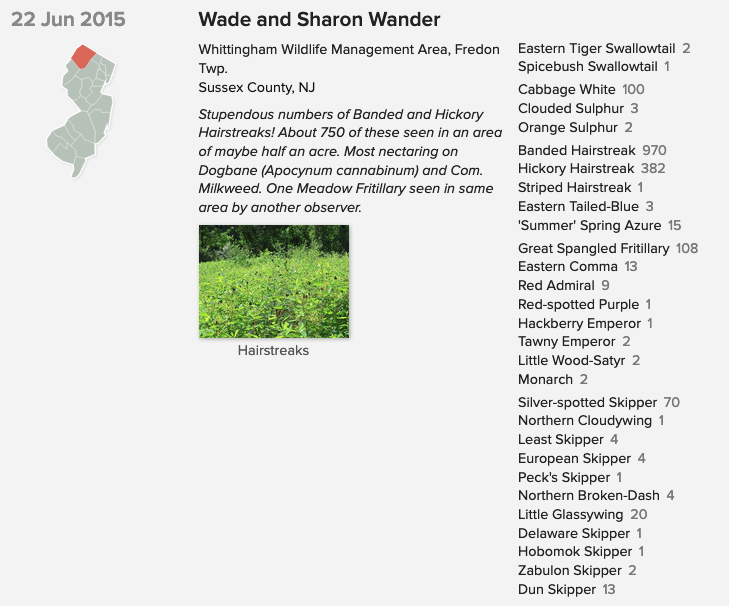Great Events in NJ Butterfly History
By Sharon & Wade Wander
This is a new and recurring(?) feature. This kick-off submission concerns the amazing congregation of hairstreaks at the Whittingham Wildlife Management Area (WMA) in Fredon Twp., Sussex County, on June 22, 2015.
June 22, 2015, started off like many other late June days—sunny and warm with a zero percent chance of rain but a 90 percent chance of seeing lots of butterflies. We decided to stay local and visit a part of the sprawling Whittingham Wildlife Management Area only 5 minutes from our home in Fredon Twp., Sussex County. As events quickly unfolded it was a great decision. We parked in a dirt lot near the WMA headquarters building and scanned the dirt and any damp mud for the usual suspects—purples, emperors, pearly eyes, anglewings, cloaks, and admirals. Then came the fateful decision. We broke through a hedgerow to access a field with lots of Indianhemp (Apocynum cannibinum), which we knew was in flower. As we approached the edge of the Indianhemp stand, which covered about 1/2 acre, we knew something was different. Very, very, different. The air was abuzz with constant motion, not by bees but by thumbnail-sized butterflies. The dogbane was decorated with amazing numbers of little dark triangles—hairstreaks! We saw so many hairstreaks that our first thought was how to count them all. It seemed an impossible task at first. But it became apparent that Banded and Hickory were the predominant species. So, not having to concern ourselves with other species, we systematically worked our way through the stand and identified every hairstreak as one of the two, as best we could. Then we found that a similar Indianhemp stand in another field was similarly studded with hairstreaks. After another dizzying counting spree we added up the totals, which speak for themselves (see the results of that morning’s work as sent to NABA’s Butterflies I’ve Seen that day).
What was fascinating was that the following year those same Indianhemp stands were there and in bloom but produced not a single hairstreak—not one! The year before we had seen a dramatic build up of hairstreaks on the Springdale 4JC (our notes for he count read “the return of the hairstreaks!") perhaps foretelling the stupendous numbers that emerged the very next year. Several butterfliers from South Jersey and even from out-of-state came to Whittingham after reading our post. Those who came within a few days witnessed the extravaganza but those who waited a week or so missed out. Just as in chasing rare birds, the spoils go to those who act quickly. But what happened to all those hairstreaks? Was there no reproduction? Did predators respond to the huge numbers of prey and eat the eggs and caterpillars? Did a pathogen wipe them out?
The hairstreaks were the headliners but many other species were present and in good numbers. In a couple of hours two observers saw 29 species and 385 individual butterflies (apart from the 1352 Banded/Hickory hairstreaks); 2 other species in triple digits and another 5 in double digits; and 9 species of grass-skippers. Ah, those were the days.
